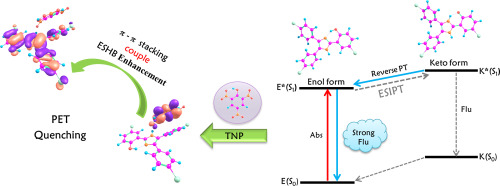Spectrochimica Acta Part A: Molecular and Biomolecular Spectroscopy ( IF 4.3 ) Pub Date : 2019-01-27 , DOI: 10.1016/j.saa.2019.01.077 Runze Liu , Yinhua Ma , Jianyong Liu , Yanqiang Yang , Tianshu Chu

|
For TNP chemosensor 2-(4,5-Bis(4-Chlorophenyl)-1H-Imidazol-2-yl)-4-Chlorolphenol (HPICI), previous thought with no theoretical basis was that excited-state intramolecular proton transfer (ESIPT) process and the ground-state HPICI-TNP complex are mainly responsible for its fluorescence emission and the detection of TNP. However, this interpretation has been proved to be wrong by the present theoretical DFT/TDDFT explorations. Actually, the strong fluorescence of HPICI is mainly induced by the local excitation of the enol form HPICI(E) without ESIPT, and the fluorescence quenching by TNP is due to the photo-induced electron transfer (PET) process together with the cooperative effect of hydrogen-bonding interaction and π-π stacking interaction coexisting in the HPICI-TNP complex. The strengthened excited-state hydrogen bond promotes the PET process, thus facilitates the fluorescence quenching. This mechanism is proposed on the basis of the theoretical analyses on molecule geometry, binding energy, Gibbs free energy, electronic transitions, and frontier molecular orbitals (FMOs).
中文翻译:

TNP化学传感器2-(4,5-双(4-氯苯基)-1H-咪唑-2-基)-4-氯酚的荧光和传感机理的新观点
对于TNP化学传感器2-(4,5-双(4-氯苯基)-1H-咪唑-2-基)-4-氯苯酚(HPICI),以前没有理论依据的想法是激发态分子内质子转移(ESIPT)过程和基态HPICI-TNP配合物主要负责其荧光发射和TNP的检测。但是,目前的理论DFT / TDDFT探索已证明这种解释是错误的。实际上,HPICI的强荧光主要是由没有ESIPT的HPICI(E)的烯醇形式的局部激发引起的,而TNP的荧光猝灭是由于光致电子转移(PET)过程以及HCPI的协同作用引起的。 HPICI-TNP配合物中同时存在氢键相互作用和π-π堆积相互作用。增强的激发态氢键促进了PET过程,因此促进了荧光猝灭。该机制是在对分子几何形状,结合能,吉布斯自由能,电子跃迁和前沿分子轨道(FMO)进行理论分析的基础上提出的。


















































 京公网安备 11010802027423号
京公网安备 11010802027423号